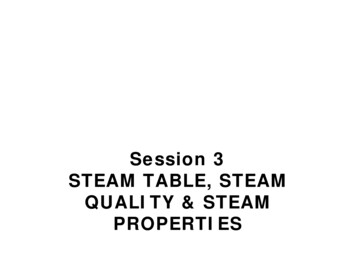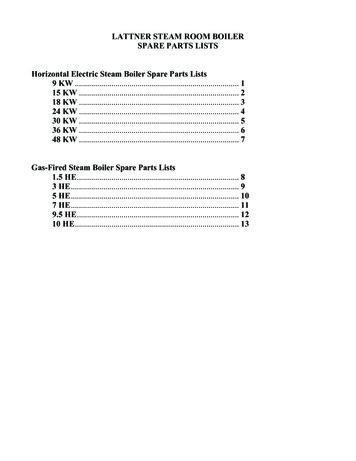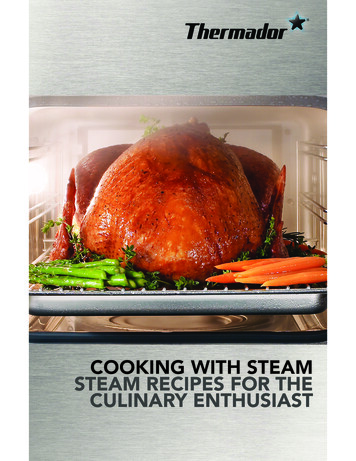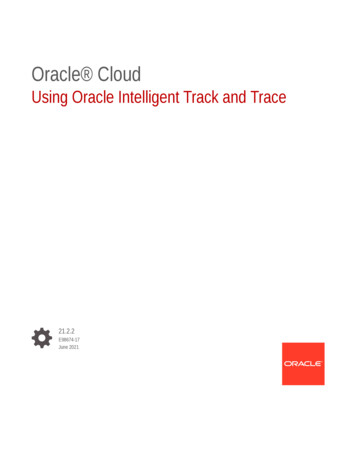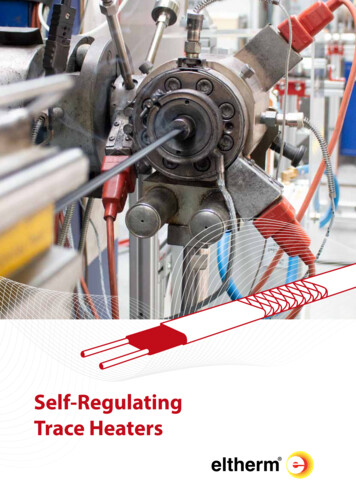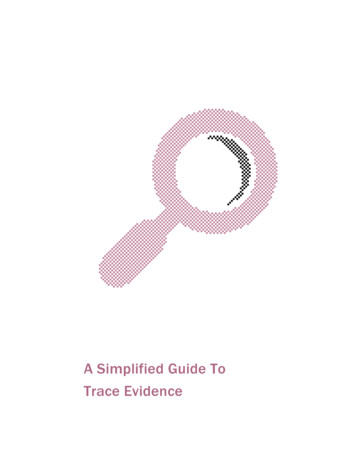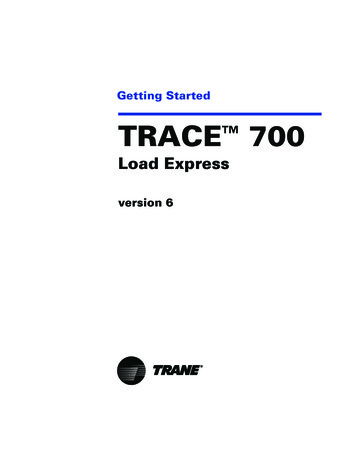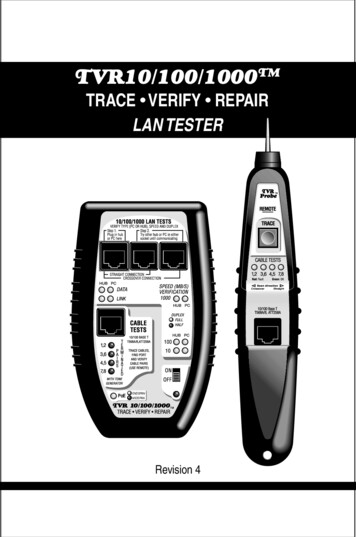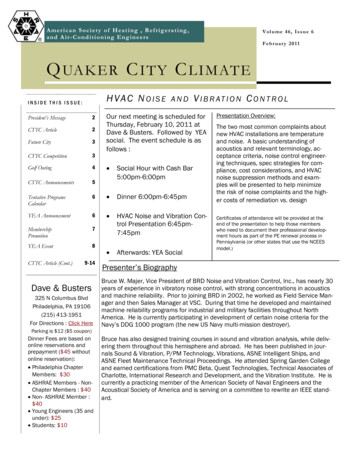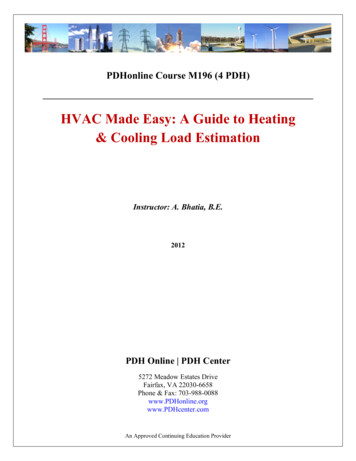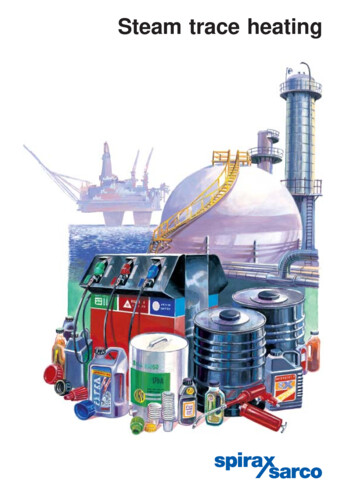
Transcription
Steam trace heating
Spirax Sarco steam tracing systemsAn efficient and reliable trace heating system is a vital componentof the modern process plant. Its use ensures that optimum pumpingviscosity is maintained, product solidification or spoilage does notoccur and damage from adverse ambient conditions is avoided.No other form of trace heating offers the all round benefits of steamin terms of efficiency, low operating costs, controllability,flexibility and above all, safety.Spirax Sarco tracing system for critical applicationSteamTemperature controlsPrevent product spoilage.Reduce energy wastage.Self-acting.Rugged construction.Piping manifoldsReduced on-site fabrication.Lower project cost.Easy maintenance.Space saving.Reduced heat losses.Swivel connectorsProvides two bolt quick fit option.Single connector for manytypes of trap.Integral isolating valve option.Thermodynamic steam trapsRemove condensate as soon as it is formed.Small and lightweight.Not damaged by freezing.Quick fit swivel connector option.Spirax Sarco has provided knowledge, service and products for the control and efficient use of steam intracing systems for over 85 years. We have a wealth of experience in its use in all industries and canprovide the expertise and products to ensure that our customers enjoy its benefits.2
The advantages of steam trace heating areacknowledged by experienced piping engineers and plant operators worldwide:Efficiency:Steam is the most efficient carrier of heat energy. Often, steam tracing systems can useexcess process steam that would otherwise go to waste.Controllability: Precise product temperatures can be maintained and tracing can be turned on and off automaticallyto suit ambient conditions. Empty product lines can be pre-heated or steam cleaned without anyproblem. Increased heat demand because of insulation degradation is automatically catered for.Reliability:Steam tracing systems are extremely rugged. Their operation is not affected by adverse conditionsand they easily withstand the normal day to day knocks that occur in a process plant.Flexibility:Steam tracer outputs are easily adjusted without the need to change the installation. Systemsare easily extended.Safety:Steam is inherently safe and suitable for use in all zones. It is the only totally 'no risk' solutionto tracing applications.Economic:Steam tracing is very simple in its concept. It is easy to design and install and uses simplemechanical components that require no external power source.Product lineSensorInsulationCondensateTrap monitoring systemsDetects steam leakage.Detects line blockage.Sealed balanced pressure steam trapsRange of capsule options.Small and lightweight.Quick fit swivel connector option.Blowdown valvesBellows sealed.Maintenance free.Zero emissions.DiffusersReduced erosion.Reduced noise.3
The need for steam tracingSteam tracing is very simple in its principle of operation. When a product in a pipeline is at a higher temperaturethan the air surrounding it, heat will pass through the wall of the pipeline from the product to the surrounding air.This heat loss will cause the temperature of the product to fall. Insulating the pipeline will significantly lower therate at which heat is lost, but unfortunately, no insulation is 100% efficient.Steam is a very efficient carrier of heat with a fixed relationship between its pressure and temperature. It cantransport heat over long distances and gives up its heat at a constant temperature.To make up the heat lost from the product pipeline, small bore steam pipes, or tracers, are attached to theproduct line. Heat from the steam passes into the product line and replaces the heat lost.The amount of heat transferred, and therefore the product temperature, can easily be controlled by simpleself-acting control systems. The same type of control can also be used in winterization applications, onlyallowing steam into the tracing line when the ambient temperature falls below a predetermined level.Heat lossfrom productpipelineJacketed pipelineAir ventProductInsulationHeat fromtracer lineSteamTypes of steam heat tracingWe, at Spirax Sarco, are able to provide our customers with advice and products for all types of steam tracingfrom simple winterization to critical jacketed applications.Jacketed - used in ultra-critical applications, usually where a product temperature has to be maintained atan elevated temperature all of the time. The use of a steam jacket also allows quick pre-heating of thepipeline.Critical - here, steam tracing is used to maintain the temperature of a product that will solidify or spoilshould its temperature fall below a predetermined level.Non-critical - tracing is used to maintain the product viscosity at its optimum pumping level.Winterization - to ensure pipelines are not damaged due to freezing in adverse weather conditions.Instrument - small bore steam tracing pipes, normally 10 mm, used to protect flowmeters, control valves,sampling stations, impulse lines etc.Product lineSteam inTA10A controlwith ambient sensorSteamdistributionmanifoldCondensate outProduct lineCondensatecollectionmanifoldTracing lineSwivelconnectorUTD steam trapSpirax Sarco tracing system for a non-critical application4UBP30steam trapBlowdown with diffuser
Determining tracer requirementsTo select the size and number of steam tracing lines required for a particular application, the rate of heat lossfrom the product pipeline under worst design conditions must be determined.This rate of heat loss is dependant upon the difference between the product temperature and the ambienttemperature. Other factors such as the thermal conductivity of the insulation, ambient wind speed and the emissivityof the insulation surface will affect this rate of loss.Table 1 provides heat loss figures for insulated product pipelines up to 500 mm diameter with alternativefigures for both 50 mm and 100 mm thickness insulation.The Table gives rates for an average wind speed of 10 m / s which will be suitable for most applications.Once the heat loss per metre from the insulated product pipeline is determined from Table 1, a suitable steamtracing line can be selected from Table 2. In some cases, multiple tracing lines fitted in parallel may be required.Table 2 gives practical heat transfer rates from a steam tracing line into a product line. They already take intoaccount losses from the tracing line to the surrounding air through the insulation.The use of heat transfer cement as a fillet between the tracer and the product line will increase the rates shownin Table 2 by a factor of at least 2. It will also prevent hot spots and uneven heating.Table 1 Heat loss from insulated process pipes - W / mProcess pipeline diameter100 mmProduct / ambientTemperature difference CInsulationthickness2575100125150175200150 mm200 mm250 mm300 mm400 mm500 3191217Note: 0.05 W / m K thermal conductivity insulation with a medium to low emissivity claddingTable 2 Output from steam tracing lines - W / mSteel (NB)SteampressureProducttemperature CTracerDia.3 bar g5 bar gCopper (OD)7 bar g9 bar g3 bar g5 bar g7 bar g9 bar 5mm20mm15mm20mm10 11350 7975 58100 278634818135104846424Calculating steam demandTo calculate actual steam demand, the following simple formulae can be used:-m Steam demand (kg / h)Total steam demandm Q x L x 3.6h fgIndividual tracer steam demandm Q x L x 3.6h fg x nQ Heat loss from Table 1 (W / m)L Length of traced product pipeline (m)h f g Specific enthalpy of evaporation (kJ/kg)3 bar g 2 133 kJ / kg5 bar g 2 086 kJ / kg7 bar g 2 048 kJ / kg9 bar g 2 015 kJ / kgn Number of parallel tracers per length ofproduct pipeline5
Determining tracer requirements exampleA temperature of 100 C in a 300 mm line needs to be maintained. The minimum design ambient temperatureis -15 C, steam pressure is 5 bar g and the line is 200 m long. The product line has 100 mm thick insulationwith aluminium low emissivity cladding. Steam tracing lines will be steel, fitted in 50 metre lengths.Step 1 - Determine heat loss from product line1.11.21.31.4Temperature difference between product and ambient air 100 C - (-15 C) 115 C.From Table 1, next temperature difference line (left scale) above 115 C is 125 C.Follow 125 C temperature difference line across table until the figure for 300 mm pipe with 100 mm thickinsulation is reached.Read off heat loss figure - 94 W / mStep 2 - Select suitable tracer(s)2.12.2From Table 2, select the 100 C product temperature line from the left scale.Follow the line across and read the tracer outputs from the 5 bar g column in the steel tracer section.15 mm NB tracer 50 W / m output20 mm NB tracer 64 W / m outputIn this instance two 15 mm NB tracers fitted in parallel will be selected to provide the 94 W / m required tomake up the heat losses from the product line. Note that if heat transfer cement were used, only one15 mm NB tracer line would be required.Step 3 - Calculate steam demand3.1Total steam demand3.2Individual tracer steam demand94 W / m x 200 m x 3.6 32 kg / h2 086 kJ / kg94 W / m x 50 m x 3.6 4 kg / h2 086 kJ / kg x 2Spirax Sarco steam tracing productsSpirax Sarco manufacture a range of high quality products for steam tracing systems.For assistance and advice on the most suitable components for your tracing systemplease contact your local Spirax Sarco company. Swivel connector steam traps Spirax Sarco manufacture a complete range of lightweight,stainless steel steam traps for tracing applications.Their rugged design ensures reliable operationunder all operating conditions.If necessary, swivel connector steam traps can be replacedvery quickly without the need to break into the tracing line.Steam distribution andcondensate collection manifoldsSpace saving forged manifolds with integral piston valveseliminate the need for on site fabrication and testing.Available in a number of configurations, all with pre-drilledmounting points.Mounting kits and insulating jackets are available to furtherease installation.6
Self-acting temperature controlsSimple, reliable, self-contained temperature control systemsthat are intrinsically safe and require no external powersource.The TA10 control range, designed specifically for tracingapplications, is manufactured from stainless steel andincorporate a bellows sealed valve arrangement. Steam trap monitoring Spiratec provides a simple and accurate method of monitoringsteam trap performance under operating conditions.It will help save energy by reporting steam traps which havefailed open and protect critical tracing applications byreporting steam traps which have failed closed.DiffusersFitted to the outlet of steam traps or blowdown valvesdischarging to atmosphere, the Spirax Sarco diffuser greatlyreduces the problem of noise and erosion.At 1 metre the sound pressure level will be reduced by 80%. Bellows sealed stop valves The bellows sealed stop valve is a zero emissions valveproviding long valve life with no maintenance.This robust valve is unaffected by vibration and will operateover a wide range of pressures and temperatures.Pilot operated pressure reducing valvesA wide range of pressure reducing valves are availablefor applications where steam pressure needs to be reduced.Spirax Sarco pilot operated pressure reducing valveswill provide accurate control of secondary pressurewhere tracer temperature needs to be constant or must notexceed a predetermined level.7
A partnership with Spirax Sarcoprovides knowledge, service and productsworldwide for the control and efficient use ofsteam and other industrial fluids.l Worldwide support from a team of 3 900 dedicatedemployees.Our comprehensiveproduct rangeincludes:lBoiler controlslFlowmetersll Local access to Spirax Sarco's expertise and productsthrough 39 group companies in 32 countries.l Valuable information, advice and interchange of ideasfrom customer training courses held in any of our31 training centres worldwide.lll A comprehensive range of the highest quality products.lSpirax Sarco worldwide servicelEuropeAmericasAustria ViennaBelgium ZwijnaardeCzech Republic PragueDenmark CopenhagenFinland HelsinkiFrance TrappesGermany KonstanzHungary BudapestIreland DublinItaly MilanNetherlands MaarnNorway OsloPoland WarsawPortugal LisbonRussia St. PetersburgSpain BarcelonaSweden StockholmSwitzerland Zürich - ZollikonUnited Kingdom CheltenhamArgentina Buenos AiresBrazil São PauloCanada TorontoMexico MonterreyUSA Columbia, S.C.AfricaKenya NairobiNigeria LagosSouth Africa JohannesburgChina ShanghaiHong Konglndia PoonaIndonesia JakartaJapan TokyoKorea SeoulU.A.E. DubaiMalaysia Kuala LumpurPakistan KarachiPhilippines ManilaSingaporeTaiwan TaipeiThailand BangkokPressure reducing valvesSelf-acting temperaturecontrol valvesProgrammable electroniccontrollersPneumatic transmittercontrollerslSafety valveslSteam trapslAsia & Middle EastPneumatically andelectronically actuatedcontrol valvesSteam trap monitoringsystemslCondensate pumpslFlash vesselslSeparatorslStrainerslStop valvesAustralasialCheck valvesAustralia SydneyNew Zealand AucklandlHumidifiersTRACEA further 46 agencies operate throughout the world.If you have difficulty finding a local contact please contact us at the number shown below.Spirax-Sarco Limited, Charlton House,Cheltenham, Gloucestershire, GL53 8ER UK.Tel: 44 (0)1242 521361 Fax: 44 (0)1242 573342E-mail: Enquiries@SpiraxSarco.comInternet: www.SpiraxSarco.com Copyright 2001Spirax Sarco is a registered trademark of Spirax-Sarco Limit
The need for steam tracing Steam tracing is very simple in its principle of operation. When a product in a pipeline is at a higher temperature than the air surrounding it, heat will pass through the wall of the pipeline from the product to the surrounding air. This heat loss will cause the temperature of the product to fall. Insulating the pipeline will significantly lower theFile Size: 959KBPage Count: 8
